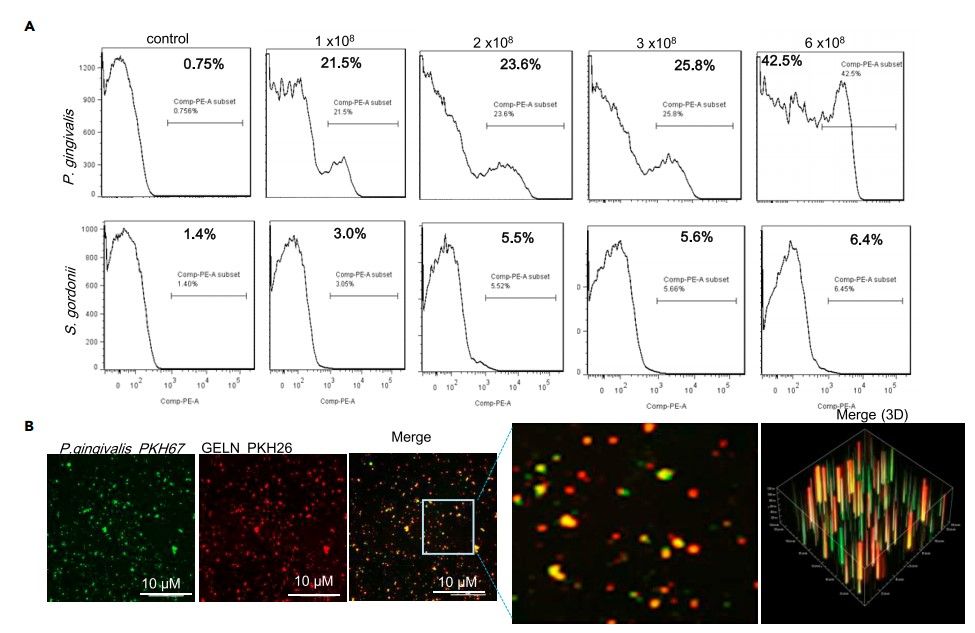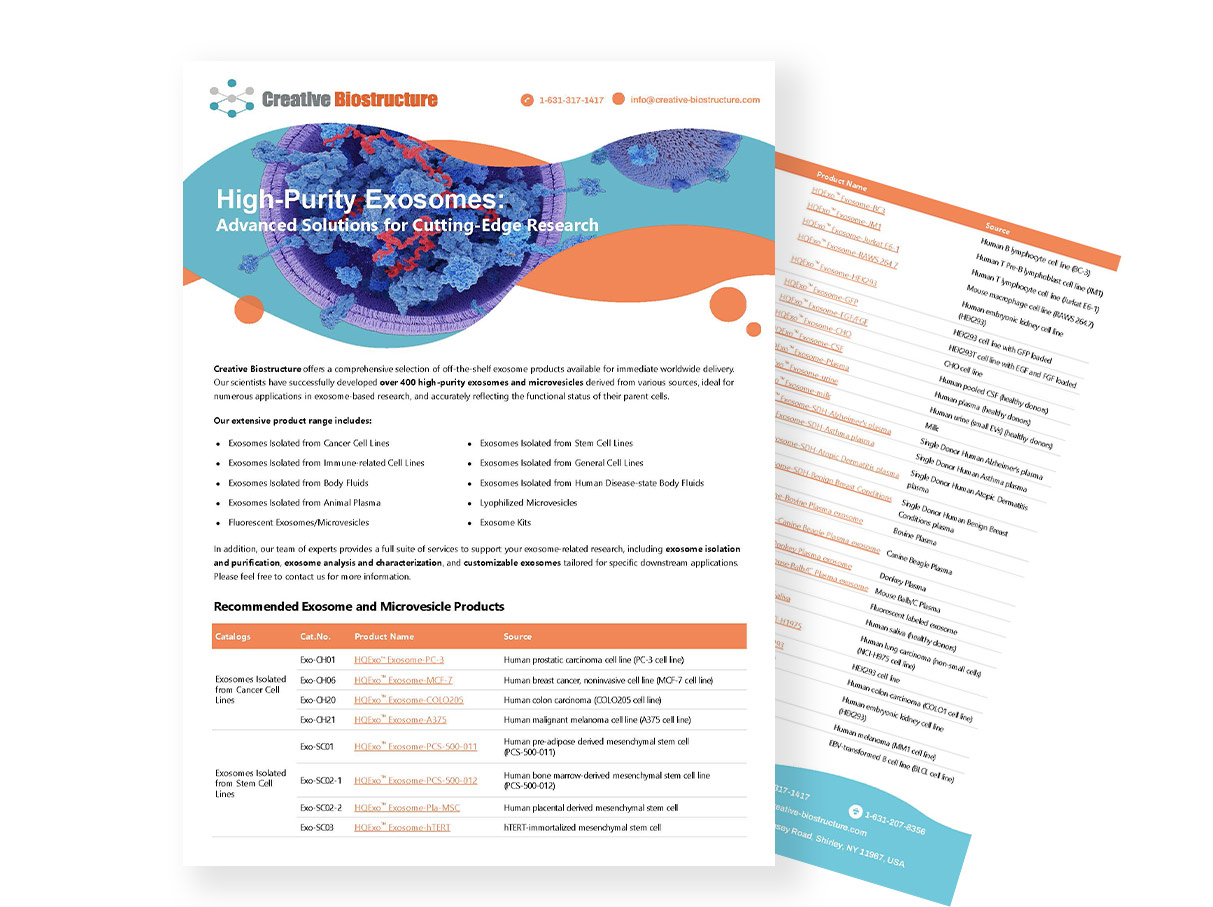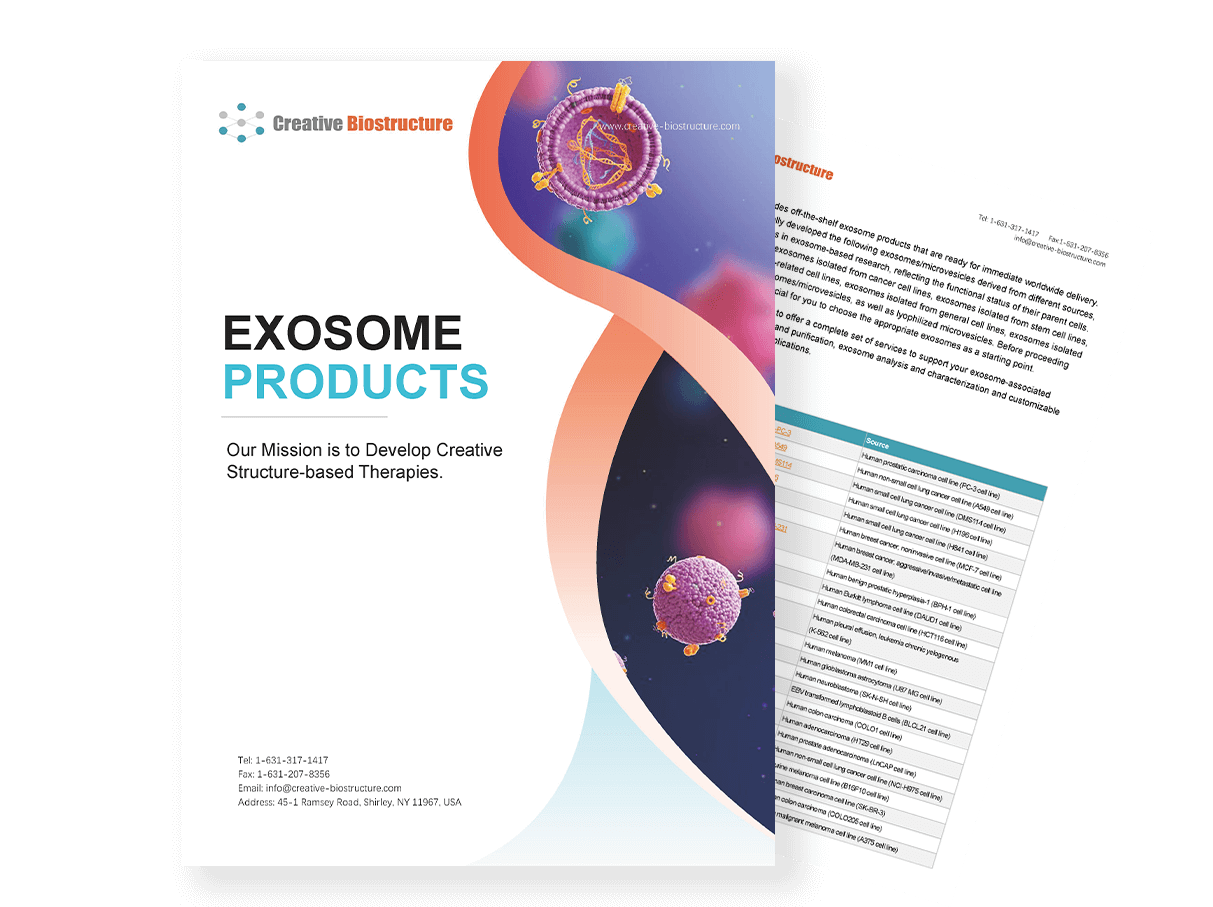Exosomes Isolated from Plant
Exosomes from plants are membrane vesicles with nanoparticles (30-150 nm) that contain a number of bioactive biomolecules. In many applications, such as skin care, drug delivery and biomedicine, they have been shown to have multiple uses. Exosomes from plants possess antioxidant, anti-inflammatory and anti-aging, and therefore an appealing option for new therapies. Besides, plant-derived natural chemicals are commonly applied as cosmetics because they are beneficial to human skin—anti-aging, moisturizing, lightening, rejuvenating, nourishing. Furthermore, such exosomes could transport drugs directly to the target cells, potentially transforming drug delivery methods. On the whole, exosomes from plants can potentially be exploited in many different applications in medicine, biotechnology and cosmetics, and more.
Creative Biostructure provides a comprehensive line of PNExoTM Exosomes isolated from plants and processed to the highest levels of purity and activity for your needs. We also offer customized GMP-grade exosome isolation services suitable for applications in skincare, nutritional supplements, and more.
Product List
Background
The discovery of exosomes in plants has extended the role of exosomes in intercellular communication and signaling pathways. The similarities between the plant exosomes (plant exosome-like nanoparticles (PELNs)) and their mammalian relatives have been highlighted in recent years. Exosomes from plants are formed by the same process as those in animal cells—the invasion of the plasma membrane, then they fused with the plasma membrane and released from the cell.
Exosomes of plants are different species to species and developmental stage to developmental stage. They are rich in proteins (enzymes, transcription factors, membrane proteins) and various RNAs, including messenger RNAs (mRNAs), microRNAs (miRNAs), and small interfering RNAs (siRNAs). And their lipid composition—phospholipids, glycolipids and sterols—also describes their cellular origin and are essential for their structural integrity and function.
Exosomes produced by plants are known to have a range of physiological functions, from stress-tolerance to resistance to phytopathogens and uptake of nutrients. Plant exosomes, for example, have been reported to contain stress-responsive proteins and RNAs that allow the plant to compensate for perturbations in the environment. Plant exosomes also coordinate the contact with microbes, which means that they can influence symbiosis or antimicrobial defenses.
 Figure 1. Sources, biogenesis, and contents of plant-derived exosomes. (Sarasati A, et al., 2023)
Figure 1. Sources, biogenesis, and contents of plant-derived exosomes. (Sarasati A, et al., 2023)
Applications of Exosomes Isolated from Plant
Targeted Delivery and Genetic Modification
The natural biocompatibility, stability and bioactive molecules carrying capacity of plant exosomes make them desirable carriers for nucleic acids, proteins and pharmaceuticals. Recent studies have explored surface modifications of plant exosomes—like the attachment of folic acid—that would increase their uptake by specific cells, including cancer cells. Such selective delivery of the plant exosome means its cargo goes directly to diseased cells—allowing precise genetic engineering or drug delivery with as little interference as possible on normal cells.
Moreover, exosomes from plants can be engineered with specific genetic material (e.g., miRNAs or other small RNAs) that silence or modulate target genes in the recipient cells. That could present an opportunity for their application in gene therapy—the exosomes could then be used to transfer genetic material for treatment of genetic disease, cancer or another pathology.
Immunology Research
Plant-derived exosomes are ripe for use in immunology because they regulate the immune system. Exosomes isolated from plants can also modulate immune pathways by modulating inflammation-related mRNAs and inhibiting key signaling pathways such as AKT, GSK3, Nrf2 and NF-κB. This effect suppresses the release of inflammatory mediators such as TNF-α and IL-1β, so exosomes could be natural immunomodulators. The miRNAs in plant exosomes are central to these effects, and can interfere with inflammatory signals both on the transcriptional and translational levels. Immunomodulatory activity of such exosomes creates an ideal environment for the investigation of immunoregulatory processes and the design of potential immune therapies.
Potential as Antioxidants and Anti-Aging Drugs
Plant exosomes are rich in antioxidants and protect cells from oxidative stress. These exosomes release miRNAs (e.g., miR-CM1) that target markers of oxidative stress, which reduce reactive oxygen species (ROS) levels and promote cellular resilience. This antioxidant action helps minimize cellular damage and holds promising applications in anti-aging research, where plant-derived exosomes have been found to promote wound healing and support mitochondrial function. Continued research on these exosomes as potential antioxidants and anti-aging agents is therefore invaluable.
Potential as Anti-Tumor Agents
Studies have reported the anti-tumor effects of plant-derived exosomes, such as Salvia dominica, which demonstrated cytotoxicity in cancer cells. The accumulation of exosomes isolated from plant in the cytoplasm of cancer cells triggers reprogramming toward cell death, making them useful for studying anti-cancer mechanisms and evaluating natural sources of plant-derived exosomes as potential tumor suppressors.
Nutrient Supplements
Plant-derived exosomes could be used as nutrient supplementation in the delivery of bioactive vitamins, minerals, and phytochemicals. With their natural composition, these exosomes can offer higher bioavailability and bioactive targeting of said nutrients, which could improve their effectiveness. It is also theorized that these exosomes may help to deliver nutrients to the digestive system and, hence, have utility in dietary supplement development for health and wellness.
Cosmetics
Exosomes from plants are starting to gain popularity in cosmetics for skin health. They have bioactive molecules, such as proteins, lipids and RNA, which can repair, moisturize and rejuvenate the skin. These exosomes can enhance skin barrier function, lower inflammation and act as antioxidants. Because they deliver these beneficial molecules to skin cells, they can be an attractive candidate for anti-aging creams, skin-lightening lotions and as an exfoliant for the delicate skin.
Case Studies
Case Study 1: Protective Effects of Ginger Exosome-Like Nanoparticles Against Periodontal Pathogens
The Sundaram team focus here is to examine whether plant exosome-like nanoparticles (PELNs)—ginger exosome-like nanoparticles (GELNs)—can protect mammalian hosts from infection. They find that GELNs are actively recruited by the periodontal pathogen Porphyromonas gingivalis via a phosphatidic acid (PA)-dependent mechanism with hemin-binding protein 35 (HBP35) on the surface of the bacteria. By interacting with it, GELN cargo molecules, such as PA and microRNAs (miRs), significantly reduce the pathogenic mechanisms of P. gingivalis by targeting multiple pathogenic factors simultaneously. The study also demonstrates the therapeutic potential of edible PELNs for preventing or treating chronic periodontitis in a mouse model. It also shows the promising use of plant-derived nanoparticles to attack bacterial infections.
 Figure 2. Ginger exosome-like nanoparticles (GELNs) selectively inhibit growth of the pathogenic P. gingivalis but not the commensal S. gordonii. (A) P. gingivalis and S. gordonii were incubated with different concentrations (0 - 6.0 x 108 particles/mL) of PKH26-labeled GELNs for 1 h in an anaerobic chamber. GELN uptake by P. gingivalis and S. gordonii was quantified by flow cytometry. (B) P. gingivalis and GELNs were labeled with fluorescent dyes PKH67 and PKH26, respectively. Then, P. gingivalis and GELNs were incubated at 37 °C for 1 h in anaerobic chamber and fluorescence images were taken by confocal microscopy. (Sundaram K, et al., 2019)
Figure 2. Ginger exosome-like nanoparticles (GELNs) selectively inhibit growth of the pathogenic P. gingivalis but not the commensal S. gordonii. (A) P. gingivalis and S. gordonii were incubated with different concentrations (0 - 6.0 x 108 particles/mL) of PKH26-labeled GELNs for 1 h in an anaerobic chamber. GELN uptake by P. gingivalis and S. gordonii was quantified by flow cytometry. (B) P. gingivalis and GELNs were labeled with fluorescent dyes PKH67 and PKH26, respectively. Then, P. gingivalis and GELNs were incubated at 37 °C for 1 h in anaerobic chamber and fluorescence images were taken by confocal microscopy. (Sundaram K, et al., 2019)
Case Study 2: The Role of Rice-Derived MicroRNA in Glucose Regulation and Disease Prevention
This study focuses on hvu-MIR168-3p found in rice aleurone cell nanoparticles and demonstrates its ability to downregulate genes associated with the mitochondrial electron transport chain complex I in human cells. This interaction leads to increased expression levels of glucose transporter I (GLUT1) and subsequent lowering of blood glucose levels, as demonstrated by both in vitro and in vivo experiments. The results suggest a plant-human cross-kingdom relationship mediated by hvu-MIR168-3p and suggest its potential application in preventive medicine for GLUT1-related dysfunctions, including glucose metabolism, aging, and tumor immunology.
 Figure 3. Effects of rice PENs on growth and GLUT1 expression in human rhabdomyosarcoma cells (RD cells) and uptake of PENs by IEC6 cells. (A) Incubation of RD cells with a solution of rice PENs for 72 h enhanced growth and GLUT1 expression exosomal dose-dependently. (B) IEC6 cells were exposed to PENs labeled with PKH26 (red). White arrows indicate PKH26-labeled PENs taken into IEC6 cells. Observation was made at 17 h after exposure to the labeled PENs (red, upper photograph). A 3D image composed of Z-sections of IEC6 cells (lower photograph). N: nucleus stained with DAPI (blue). Perinuclear localization of labeled PENs (red) is indicated (lower photograph). Bars = 10 and 20 μm. IEC6: intestinal epithelial cells; PEN: plant-derived exosome-like nanoparticles. (Akao Y, et al., 2023)
Figure 3. Effects of rice PENs on growth and GLUT1 expression in human rhabdomyosarcoma cells (RD cells) and uptake of PENs by IEC6 cells. (A) Incubation of RD cells with a solution of rice PENs for 72 h enhanced growth and GLUT1 expression exosomal dose-dependently. (B) IEC6 cells were exposed to PENs labeled with PKH26 (red). White arrows indicate PKH26-labeled PENs taken into IEC6 cells. Observation was made at 17 h after exposure to the labeled PENs (red, upper photograph). A 3D image composed of Z-sections of IEC6 cells (lower photograph). N: nucleus stained with DAPI (blue). Perinuclear localization of labeled PENs (red) is indicated (lower photograph). Bars = 10 and 20 μm. IEC6: intestinal epithelial cells; PEN: plant-derived exosome-like nanoparticles. (Akao Y, et al., 2023)
Product Advantages
- Cost-Effective Solutions: We make our plant-derived exosomes using scalable methods that significantly decrease production costs relative to animal-based products. This means that you can get the best quality products without exceeding your budget.
- Natural and Biocompatible: Derived from a variety of edible plants, our exosomes are created to minimize the risk of adverse reactions. They're also perfect for targeted drug delivery and skincare applications.
- Rich in Bioactive Components: Our exosomes are enriched with bioactive components, such as essential proteins, lipids, and microRNAs, providing potent health benefits. Please check our product details page or contact us for detailed information.
- Sustainable Practices: We are sustainability-oriented and we source our plant products ethically. It aligns well with the market demand for sustainable and responsible materials.
Resources
Frequently Asked Questions
-
What's the difference between plant exosomes and animal exosomes?
Exosomes derived from plants, or exosome nanoparticles—these nanosized extracellular molecules from plants. Similar to exosomes from animals, they're packed with bioactive molecules such as proteins, lipids and microRNAs. But the plant-derived exosomes are more sustainable and biocompatible than the animal-derived exosomes—that is, less side-effects and more therapeutic benefits.
-
Where do your plant exosomes come from and how are they isolated?
Our plant-derived exosomes come from various edible plants and are purified and bioactive according to the cutting-edge extraction technology. We use ultracentrifugation and size-exclusion chromatography to isolate and purify the exosomes effectively
-
Which plant exosomes do you offer?
We have nearly 250 PNExoTM plant exosomes available for all your research and industrial needs. In addition, we offer exosome isolation services for your specific research and industrial applications.
At Creative Biostructure, we are dedicated to promoting your research and application efforts with our high-quality, innovative plant-derived exosomes. Explore our offerings today and contact us to find the ideal solution for your applications!
References
- Akao Y, Kuranaga Y, Heishima K, et al. Plant hvu-MIR168-3p enhances expression of glucose transporter 1 (SLC2A1) in human cells by silencing genes related to mitochondrial electron transport chain complex I. The Journal of Nutritional Biochemistry. 2022;101:108922.
- Sarasati A, Syahruddin MH, Nuryanti A, et al. Plant-derived exosome-like nanoparticles for biomedical applications and regenerative therapy. Biomedicines. 2023;11(4):1053.
- Sundaram K, Miller DP, Kumar A, et al. Plant-derived exosomal nanoparticles inhibit pathogenicity of porphyromonas gingivalis. iScience. 2019;21:308-327.
- Yi Q, Xu Z, Thakur A, et al. Current understanding of plant-derived exosome-like nanoparticles in regulating the inflammatory response and immune system microenvironment. Pharmacological Research. 2023;190:106733.



